

Colorín Colorado. In content-area courses, English language learners (ELLs) have a double challenge: they must learn language and content at the same time.
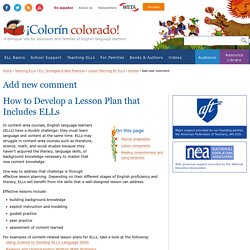
ELLs may struggle in content-area courses such as literature, science, math, and social studies because they haven't acquired the literacy, language skills, or background knowledge necessary to master that new content knowledge. One way to address that challenge is through effective lesson planning. Depending on their different stages of English proficiency and literacy, ELLs will benefit from the skills that a well-designed lesson can address. Effective lessons include: building background knowledgeexplicit instruction and modelingguided practicepeer practiceassessment of content learned. Globalmetacognition. Teach Kids to Think About Their Thinking. 25 Best Reading-Read Alouds to Teach Metacognitive Strategies images. Thinking About Thinking: How to Challenge & Change Metacognitive Beliefs. Why Do Smart People Do Foolish Things?
We all probably know someone who is intelligent but does surprisingly stupid things.
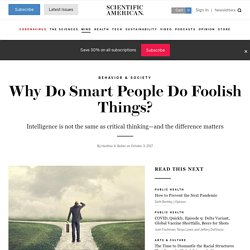
My family delights in pointing out times when I (a professor) make really dumb mistakes. What does it mean to be smart or intelligent? Our everyday use of the term is meant to describe someone who is knowledgeable and makes wise decisions, but this definition is at odds with how intelligence is traditionally measured. The most widely known measure of intelligence is the intelligence quotient, more commonly known as the IQ test, which includes visuospatial puzzles, math problems, pattern recognition, vocabulary questions and visual searches. Metacognition: Nurturing Self-Awareness in the Classroom. How do children gain a deeper understanding of how they think, feel, and act so that they can improve their learning and develop meaningful relationships?
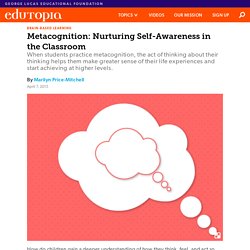
Since antiquity, philosophers have been intrigued with how human beings develop self-awareness -- the ability to examine and understand who we are relative to the world around us. Today, research not only shows that self-awareness evolves during childhood, but also that its development is linked to metacognitive processes of the brain. Making Sense of Life Experiences Most teachers know that if students reflect on how they learn, they become better learners.
For example, some students may think and process information best in a quiet library, while others may focus better surrounded by familiar noise or music. : Article. Background: Technology represents a major topic in educational research.
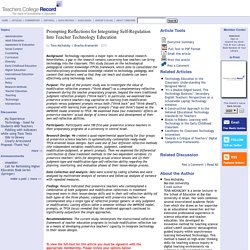
Nevertheless, a gap in the research remains concerning how teachers can bring technology into the classroom. This study focuses on the technological pedagogical content knowledge (TPCK) framework, which aims to consolidate the multidisciplinary professional knowledge related to technology, pedagogy, and content that teachers need so that they can teach and students can learn effectively using technology tools. Purpose: The goal of the present study was to investigate the value of modification reflection prompts (“think ahead”) as a complementary reflective framework during the teacher preparatory program, beyond the more traditional judgment reflection prompts (“think back”).
Participants: Participants were 199 first-year preservice science teachers in their preparatory programs at a university in central Israel. Bracha Kramarski - Google Scholar Citations. WH- Questions Worksheets: 7 Activities with Who, What, When, Where and Why Questions - ALL ESL. WH- Questions Worksheets: Who, What, When, Where and Why Questions Who, what, when, where and why.
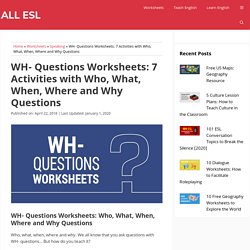
We all know that you ask questions with WH- questions… But how do you teach it? That’s why we’ve created 7 worksheets that helps practice who, what, when, where and why questions. From best to worst, we’ve ranked our WH- questions worksheets based on user feedback. 12 metacognition-modelling strategies for the foreign language classroom. Metacognitive skills are arguably the most important set of skills we need for our journey through life as they orchestrate every cognitive skill involved in problem-solving, decision-making and self-monitoring (both cognitive and socio-affective).
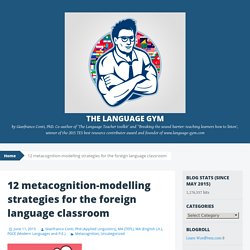
We start acquiring them at a very early age at home, in school, in the playground and in any other social context an individual interacts with other human beings. But what are metacognitive skills? What is metacognition? I often refer to metacognition as ‘the voice inside your head’ which helps you solve problems in life by asking you questions like: Diane F. Halpern. Diane F.
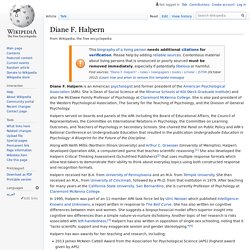
Halpern is an American psychologist and former president of the American Psychological Association (APA). She is Dean of Social Science at the Minerva Schools at KGI (Keck Graduate Institute) and also the McElwee Family Professor of Psychology at Claremont McKenna College. She is also past-president of the Western Psychological Association, The Society for the Teaching of Psychology, and the Division of General Psychology. Five Ways to Boost Metacognition In the Classroom. The Metacognitive Reading Strategies Questionnaire (MRSQ): Cross-Cultural Comparisons - Improve with Metacognition.
By Roman Taraban, Ph.D.
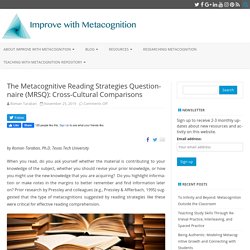
Texas Tech University When you read, do you ask yourself whether the material is contributing to your knowledge of the subject, whether you should revise your prior knowledge, or how you might use the new knowledge that you are acquiring? Do you highlight information or make notes in the margins to better remember and find information later on? Prior research by Pressley and colleagues (e.g., Pressley & Afflerbach, 1995) suggested that the type of metacognitions suggested by reading strategies like these were critical for effective reading comprehension. Multimodal data to design visual learning analytics for understanding regulation of learning. Meditation Breathe GIF. Five Ways to Boost Metacognition In the Classroom. Metacognition – Think About It! My school had one of the highest reading achievement levels in the district.

However, for seven straight years, our reading scores didn’t move up an inch. Most of our students could read at or above grade level. They had mastered all the important who, what, where, when, and why questions. They could answer setting and main character questions. So what was the problem? Our students weren’t thinking! Reading instruction consisted of students reading passages and answering a set of questions posed by either the teacher or a multiple-choice quiz. What made our reading scores improve? In this article, we’ll review strategies for helping students deepen their thinking and improve their reading skills through metacognition.
Step 1: Listening to Your Inner Voice The first step in strengthening reading instruction is to teach students to listen to their inner voices as they read. Step 2: Speaking and Listening to Others. Reader's Workshop - Metacognition. Brain Games are Bogus. A decade ago, a young Swedish researcher named Torkel Klingberg made a spectacular discovery.
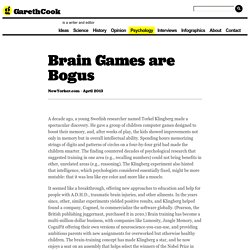
He gave a group of children computer games designed to boost their memory, and, after weeks of play, the kids showed improvements not only in memory but in overall intellectual ability. Spending hours memorizing strings of digits and patterns of circles on a four-by-four grid had made the children smarter. The finding countered decades of psychological research that suggested training in one area (e.g., recalling numbers) could not bring benefits in other, unrelated areas (e.g., reasoning). Is a writer and editor. Visible Body - Virtual Anatomy to See Inside the Human Body. Quick, Draw! Baader-Meinhof Phenomenon: a Curious Cognitive Effect. Have you ever learned about a new word, fact, idea or product and subsequently see it everywhere around you? This curious cognitive effect is known as the Baader-Meinhof Phenomenon.
So, is it just a coincidence? Or is there a scientific explanation behind this phenomenon? Building an approximation of human emotions into robots might allow empathy. Brain scan study links social anxiety to an empathy "imbalance" We all know the feeling: You are in a group of people, and suddenly, someone messes up big time. You cringe, wince, and look away — if it were you, you would be mortified. You are embarrassed for them. It's one of the most relatable aspects of social anxiety — and a new study points to the neurobiology that governs it.
More than one in ten American adults will experience social anxiety disorder over the course of their lives‚ feeling waves of distress pinned to social interaction. But some suffer from a specific kind of social anxiety — one that flips the usual feelings of embarrassment on their head. What Is Bloom's Taxonomy? A Definition For Teachers - What Is Bloom’s Taxonomy? A Definition For Teachers by TeachThought Staff In one sentence, Bloom’s Taxonomy is a hierarchical ordering of cognitive skills that can, among countless other uses, help teachers teach and students learn. For example, Bloom’s Taxonomy can be used to: create assessments plan lessons (see 249 Bloom’s Taxonomy Verbs For Critical Thinking) evaluate the complexity of assignments design curriculum maps develop online courses plan project-based learning self-assessment more See How To Teach With Bloom’s Taxonomy for more reading. CriticalThinkingReviewFINAL. Google Image Result for. Metacognition. Methods of Research-AP Psychology Flashcards.
25 Best Reading-Read Alouds to Teach Metacognitive Strategies images. How Strengthening Relationships with Boys Can Help Them Learn. To support boys in our classrooms, Reichert points to one robust, consistent finding from his 30 years of research: boys are relational learners. They learn best in the context of strong, supportive relationships. In one study, Reichert and his team gathered data from 2,500 teachers and students in six different countries.
He asked the boys and their teachers one simple question: “What’s worked?” For teachers, what has worked to help you reach boys? For boys, what have teachers done that has worked to support your learning and engagement? First, effective teachers used strategies to capture boys’ attention and then carried that energy into the lesson. But another dominant theme came from the boys themselves. How to Write a Critical Review - Elite Editing. When you are required to write a critical review, you will need to do two main things: summarise and evaluate a text. The critical review can be of a book, a chapter or a journal article. You are usually asked to read the selected text in detail and also other related texts in order to present a rational and practical evaluation of the selected text. Being critical does not simply mean criticising in a negative way. Metacognition: Nurturing Self-Awareness in the Classroom.
What's Metacognition—and Why Does it Matter? Metacognitive Strategies Students Can Use to Overcome Test Anxiety. Mandala coloring, Mandala coloring pages, Coloring pages. Metacognition psychology - Recherche Google. Educational Psychologist sur Twitter : "Check out this article by Emily Rosenzweig (@emilyqr), Allan Wigfield (@AllanWigfield) and Chris Hulleman (@ChrisHulleman56) in the Journal of Educational Psychology where they build upon work by Rosenzweig and Wigf.
Will Machines Ever Become Conscious? THE LEARNING PROCESS LEARNING CHARACTERISTICS OF THE LEARNER metacognitive skills self-regulation/learning strategies learning style prior knowledge and. Metacognition EDU 330: Educational Psychology Daniel Moos. Google Image Result for.